Books by Giovanni Giambene
This book provides a basic description of current networking technologies and protocols as well a... more This book provides a basic description of current networking technologies and protocols as well as important tools for network performance analysis based on queuing theory. The second edition adds selected contents in the first part of the book for what concerns: (i) the token bucket regulator and traffic shaping issues; (ii) the TCP protocol congestion control that has a significant part in current networking; (iii) basic satellite networking issues; (iv) adding details on QoS support in IP networks. The book is organized so that networking technologies and protocols (Part I) are first and are then followed by theory and exercises with applications to the different technologies and protocols (Part II). This book is intended as a textbook for master level courses in networking and telecommunications sectors.
Papers by Giovanni Giambene
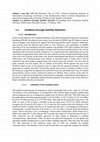
In the second edition of the Satellite Roadmap of the IEEE International Network Generations Road... more In the second edition of the Satellite Roadmap of the IEEE International Network Generations Roadmap (INGR), the physical layer issues were devoted to MIMO and RF-Optical systems. These strategies were proposed to support the following satellite needs: capacity, robustness, and security from the physical layer point of view. However, new generation of satellite networks will be also equipped with inter-satellite, and satellite-UAV links to deploy the future 3D satellite networks to provide global coverage with the lowest possible latency and, will be integrated with terrestrial networks. Moreover, it is expected that new applications such as the ones based on augmented reality and/or the ones related to climate change monitoring will play a key role in 6G systems. In this latter case, hybrid constellations that permit to combine Earth Observation and Communications may emerge. In practical terms, it means that it will be required to use other bands to support these new services since the current C, Ka, Ku ones are quite crowded. For that reason, this 3 rd edition of the IEEE INGR explores the use of the mmWave band as one of the potential ways to cope with the spectrum demand of the next generation of satellite networks. Toward this regard, this section is divided as follows. First, the frequency range that encompasses the mmWave band, the sub-bands that it has, its channel characteristics and its current commercial interest are defined. Next a review of the state-ofthe-art on its theoretical background, measurement campaigns, and hardware development is provided. Finally, the challenges and the potential solutions to the main issues of the mmWave band in Satellite networks are reported.
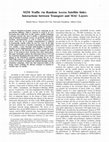
IEEE Transactions on Aerospace and Electronic Systems, 2019
Machine-to-machine services are witnessing an unprecedented diffusion, which is expected to resul... more Machine-to-machine services are witnessing an unprecedented diffusion, which is expected to result in an everincreasing data traffic load. In this context, satellite technology is playing a pivotal role, since it enables a widespread provisioning of machine-to-machine services. In particular, oil industry, maritime communications, as well as remote monitoring are sectors where the use of satellite communications is expected to dramatically explode within the next few years. In the light of this sudden increase of machine-to-machine data transported over satellite, a more thorough understanding of machine-tomachine service implementation over satellite is required, especially focusing on the interaction between transport and MAC layers of the protocol stack. Starting from these observations, this paper thoroughly analyses the interaction between TCP and the Contention Resolution Diversity Slotted Aloha access scheme defined in the DVB-RCS2 standard, assuming the use of an MQTT-like protocol to distribute machine-to-machine services. A novel TCP model is developed and validated through extensive simulation campaigns, which also shed important lights on the design choices enabling the efficient transport of machine-tomachine data via satellite.
International Conference on Universal Personal Communications, 1998
The Universal Mobile Telecommunications System (UMTS) will provide multimedia services to users i... more The Universal Mobile Telecommunications System (UMTS) will provide multimedia services to users in whatever environment via uniform service access procedures. Efficient medium access control (MAC) protocols are needed to guarantee a high capacity. This paper deals with packet reservation multiple access (PRMA), widely considered as an efficient MAC protocol in terrestrial microcellular systems, for voice and data transmissions in a
Proceedings of GLOBECOM'96. 1996 IEEE Global Telecommunications Conference
This paper deals with a study on resource management strategies in Low Earth Orbit Mobile Satelli... more This paper deals with a study on resource management strategies in Low Earth Orbit Mobile Satellite Systems (LEO-MSSs). A suitable mobility model has been proposed. Fixed Channel Allocation (FCA) has been considered. Moreover, we have foreseen that inter-beam handover requests, which do not immediately find service, can be queued in order to reduce the handover failure rate. An analytical approach has been developed to compare two different queuing disciplines and its results have been compared with simulations.

International Journal of Satellite Communications, 1997
Future mobile communication systems will be characterized by the interworking of several networks... more Future mobile communication systems will be characterized by the interworking of several networks that will be integrated into a unique system. The satellite component and the terrestrial one will use as far as possible the same protocols. This work is concerned with Medium Access Control (MAC) protocols. In particular, Packet Reservation Multiple Access (PRMA) has been considered as a good candidate for terrestrial cellular systems, since it allows high multiplexing gains, dynamic PRMA carrier allocation to cells, easy management of integrated voice and data traffic and a near-transparent behaviour with respect to user mobility. The main aim of this preliminary work is to investigate the suitability of the PRMA protocol for application to Low Earth Orbit Mobile Satellite Systems (LEO-MSSs). Moreover, we have proposed a novel version of the PRMA protocol, named PRMA with Hindering States (PRMA-HS), that is particularly suitable for application in LEO systems. This new technique has shown very promising results in terms of both packet dropping probability and throughput.
IEEE Transactions on Vehicular Technology, 1996
The interest in global spectrum allocation techniques is growing with the always increasing spect... more The interest in global spectrum allocation techniques is growing with the always increasing spectrum demand for mobile communications. This paper deals with a Dynamic Channel Allocation @.CA.) technique based on an energy function whose minimization can be performed by a Hopfield Neural Network. The performance of the proposed DCA technique is here derived by computer simulations. Comparisons with a
2019 IEEE 2nd 5G World Forum (5GWF), 2019
2013 IEEE International Conference on Communications (ICC), 2013
Lecture Notes in Computer Science, 2005
ABSTRACT

2016 IEEE Tenth International Conference on Research Challenges in Information Science (RCIS), 2016
This paper deals with the implementation of an online platform for Responsible Research and Innov... more This paper deals with the implementation of an online platform for Responsible Research and Innovation (RRI), which provides anticipatory and deliberative tools to address societal expectations with regard to resrarch and innovation and mobilises information technology tools for inclusive, responsive and sustainable research. In particular, we have developed a Forum, which is a Web-based application and service for stakeholders (members of the RRI community) to deliberate and discuss about RRI. Different interaction modalities are supported by the Forum, such as: `Caucus Process', Suggestion Board, Partnership Initiative, etc. A special attention is devoted to the Citizen Jury and Tacit Knowledge modules that represent innovative features of our Forum. The outcomes show that our online Forum represents an effective solution to address RRI issues by adopting e-Government and knowledge management approaches. This work was carried out as part of EU FP7 Responsibility project.
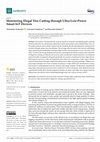
Sensors, 2021
Forests play a fundamental role in preserving the environment and fighting global warming. Unfort... more Forests play a fundamental role in preserving the environment and fighting global warming. Unfortunately, they are continuously reduced by human interventions such as deforestation, fires, etc. This paper proposes and evaluates a framework for automatically detecting illegal tree-cutting activity in forests through audio event classification. We envisage ultra-low-power tiny devices, embedding edge-computing microcontrollers and long-range wireless communication to cover vast areas in the forest. To reduce the energy footprint and resource consumption for effective and pervasive detection of illegal tree cutting, an efficient and accurate audio classification solution based on convolutional neural networks is proposed, designed specifically for resource-constrained wireless edge devices. With respect to previous works, the proposed system allows for recognizing a wider range of threats related to deforestation through a distributed and pervasive edge-computing technique. Different p...

IEEE Transactions on Wireless Communications, 2016
This paper proposes a Quality of Service (QoS) management framework for High Throughput Satellite... more This paper proposes a Quality of Service (QoS) management framework for High Throughput Satellite (HTS) systems using EHF frequency bands, which can achieve high capacity provided that feeder link outage events caused by severe weather conditions can be properly counteracted. To this regard, Smart Gateway Diversity (SGD) architectures implementing advanced gateway handover procedures are certainly attractive, although they can only partly mitigate the negative effects of adverse weather conditions in terms of packet losses, delays, and jitters, which significantly degrade the performance of delay-sensitive and-insensitive traffic flows. To cope with these technical challenges, we propose an incremental rerouting scheme to control congestion events because of capacity reduction during the transient phase, consisting in offloading high-priority QoS traffic flows from the affected gateway towards gateways operating in more favorable conditions. Moreover, we apply interflow network coding at the gateways to protect delay-insensitive flows from packet losses occurring during feeder link outage. Finally, extra capacity is reserved at the gateways to handle the additional traffic resulting from gateway handover. The theoretical analysis (validated by simulation campaigns) allowed characterizing network coding performance and confirming the potentialities of our QoS management framework for HTS systems.
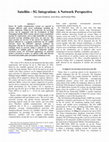
IEEE Network, 2018
Future 5G mobile communication systems are expected to integrate different radio access technolog... more Future 5G mobile communication systems are expected to integrate different radio access technologies including the satellite component. Within the 5G framework, the terrestrial services can be augmented with the development of High Throughput Satellite (HTS) systems and new mega constellations meeting 5G requirements, such as high bandwidth, low latency, increased coverage, including rural areas, air, and seas. This paper provides an overview of the current 5G initiatives and projects followed by a proposed architecture for 5G satellite networks where the SDN/NFV approach facilitates the integration with the 5G terrestrial system. In addition, a novel technique based on network coding is analyzed for the joint exploitation of multiple paths in such integrated satelliteterrestrial system. For TCP-based applications, an analytical model is presented to achieve an optimal traffic split between terrestrial and satellite paths and optimal redundancy levels.

2013 Africon, 2013
This paper proposes a new packet scheduling algorithm for a satellite Long Term Evolution (LTE) n... more This paper proposes a new packet scheduling algorithm for a satellite Long Term Evolution (LTE) network which adopts MIMO technology. The Satellite LTE air interface will provide global coverage and hence complement its terrestrial counterpart in the provision of mobile services to users across the globe. A packet scheduling algorithm is very crucial towards actualizing an effective utilization of the limited available resources in satellite LTE networks. Hence, the need for an effective packet scheduling algorithm cannot be overemphasized. The aim of this paper is to propose a new scheduling algorithm tagged QoS-Aware Fair (QAF) Scheduler that will provide a good trade-off among Quality of Service (QoS), fairness and throughput. The newly proposed scheduler is compared to existing ones through simulations and various performance indices have been used. A land mobile dual-polarized GEO satellite system has been considered for this work.
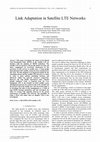
Journal of Advances in Information Technology, 2014
This paper investigates the impact of the Round Trip Propagation Delay (RTPD) in the satellite LT... more This paper investigates the impact of the Round Trip Propagation Delay (RTPD) in the satellite LTE air interface with the adoption of MIMO technology. The Satellite LTE air interface will provide global coverage and hence complement its terrestrial counterpart in the provision of LTE services to mobile users. A land mobile dual-polarized GEO satellite system has been considered for this work. The link adaption is an important module for the scheduling scheme and the satellite LTE network as a whole in order to make optimal scheduling decisions and effectively utilize the network resources respectively. However, the long RTPD experienced when Channel Quality Indicator (CQI) is reported from the User Equipment (UE) to the eNodeB via GEO satellite causes misalignment between the reported CQI at the eNodeB and the present CQI of the mobile user. The aim of this paper is to investigate the effect of the misalignment as a result of long RTPD through simulations and also investigate the effect of varying CQI reporting interval on the system performance of Satellite LTE network. The possibility of using a fixed CQI rather than an adaptive CQI is also investigated.
International Journal of Satellite Communications and Networking, 2003
ABSTRACT

Advanced Science Letters, 2014
This paper investigates the impact of the Round Trip Propagation Delay (RTPD) in the satellite LT... more This paper investigates the impact of the Round Trip Propagation Delay (RTPD) in the satellite LTE air interface with the adoption of MIMO technology. The Satellite LTE air interface will provide global coverage and hence complement its terrestrial counterpart in the provision of LTE services to mobile users. A land mobile dual-polarized GEO satellite system has been considered for this work. The link adaption is an important module for the scheduling scheme and the satellite LTE network as a whole in order to make optimal scheduling decisions and effectively utilize the network resources respectively. However, the long RTPD experienced when Channel Quality Indicator (CQI) is reported from the User Equipment (UE) to the eNodeB via GEO satellite causes misalignment between the reported CQI at the eNodeB and the present CQI of the mobile user. The aim of this paper is to investigate the effect of the misalignment as a result of long RTPD on the system performance of Satellite LTE network
IEEE Transactions on Vehicular Technology, 2013

IEEE Transactions on Vehicular Technology, 2019
The high data-rate of terminals together with the demand for anywhere-anytime user connectivity m... more The high data-rate of terminals together with the demand for anywhere-anytime user connectivity makes the simultaneous use of terrestrial and satellite infrastructures a necessity in mobile scenarios. To achieve a reliable and timely distribution of contents, there are important technical challenges concerning the implementation of multipath communication protocols and robust recovery mechanisms to cope with the signal degradation because of the effects of the mobile fading channel. In this respect, this paper proposes a new technique called path-based network coding to jointly exploit the availability of multiple paths and network coding to maximize the system transmission control protocol (TCP) goodput. An analytical approach allowing a formal optimization based on approximate derivations is proposed, which proves to be in good agreement with simulation results and a more accurate optimization method based on a genetic algorithm.











Uploads
Books by Giovanni Giambene
Papers by Giovanni Giambene